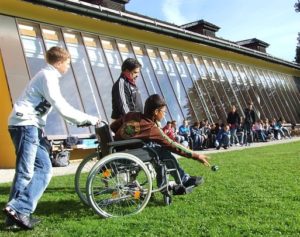When we first meet with a new family seeking services, we begin with a skills inventory of their loved one. The questions we ask can range from “Does your loved one know how to do their own laundry?” to “Do they know to lock the door when they leave?”
One individual’s parent told us, “We’ve never let our daughter walk in front of us.”
“They have never gone to 7/11 alone,” one mother explained. “What if someone took advantage of them?”
Another parent tells the story of when they were afraid their child shouldn’t take public transportation. “I worried they would get lost. Then their teacher told me they were already successfully riding the bus with other students.”
 In each of these every day activities, these parents realized that their own fear was holding their child with disabilities back. Fearing the risks that come with everyday life, parents become overprotective and try to remove obstacles for their child. However, parents understand they can’t protect their child forever. They realize that they need to let some risk in, no matter how small.
In each of these every day activities, these parents realized that their own fear was holding their child with disabilities back. Fearing the risks that come with everyday life, parents become overprotective and try to remove obstacles for their child. However, parents understand they can’t protect their child forever. They realize that they need to let some risk in, no matter how small.
Learning How To Live with Risk
Part of parenting is learning how to live with the fear of risk for your children and letting go. But for many parents of individuals with disabilities, this fear rises among surmounting challenges including funding for services, navigating benefits and life, building skill capacity, and more.
 With increasingly integrated classrooms and the rise of the independent living movement, adults with disabilities have greater access to community inclusion than ever before. As parents realize this, they wonder, “My child needs more support than other adults. How can they live on their own?”
With increasingly integrated classrooms and the rise of the independent living movement, adults with disabilities have greater access to community inclusion than ever before. As parents realize this, they wonder, “My child needs more support than other adults. How can they live on their own?”
Like with all children, parents of individuals with disabilities should begin by accepting that daily life is associated with risks. Affording your child the right to take reasonable risks benefits their self-esteem, skill development, and basic dignity.
In 1972, disability rights champion Robert Perske first wrote about the risk taking that all adults require to live a full, independent life. He wrote, “Overprotection can keep people from becoming all they could become. Many of our best achievements came the hard way: We took risks, fell flat, suffered, picked ourselves up, and tried again. Sometimes we made it and sometimes we did not. Even so, we were given the chance to try.”
Living Independently, Leading By Example
At Independent Futures, we encourage all family members to consider how they accomplished their greatest achievements. Could you have achieved your goals without help? The answer is most likely no.
Individuals with disabilities often need support in activities like budgeting, cooking, or planning. However, support professionals – and parents – can promote risk taking by teaching these crucial life skills through lessons designed to encourage independence and letting individuals experience adversity.
 Supported by life skills tutoring, individuals with disabilities can choose their goals, based on their hopes and dreams. With the support of their community – which can include family, neighbors, employers, as well as direct service professionals – people with disabilities’ quality of life can be improved immeasurably.
Supported by life skills tutoring, individuals with disabilities can choose their goals, based on their hopes and dreams. With the support of their community – which can include family, neighbors, employers, as well as direct service professionals – people with disabilities’ quality of life can be improved immeasurably.
Our life skills tutors challenge family members of individuals with disabilities to accept risks as a necessity to living a full life. This is a marathon of a challenge that all parents have to acknowledge.
Armed with goals and action plans, adults with disabilities can take advantage of the opportunities of a full life. By teaching life skills and asking your loved one to take on new responsibilities, they can live, work, and give back in the communities of their choosing.
